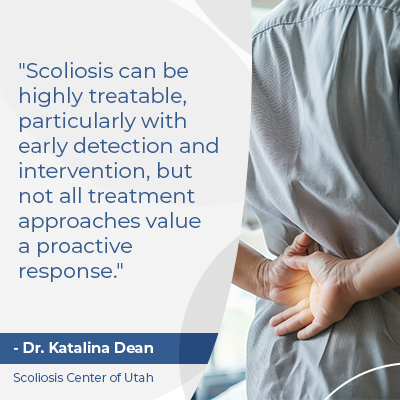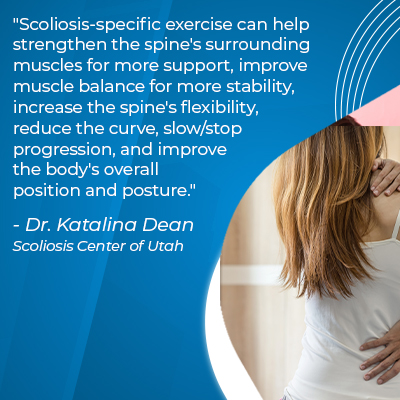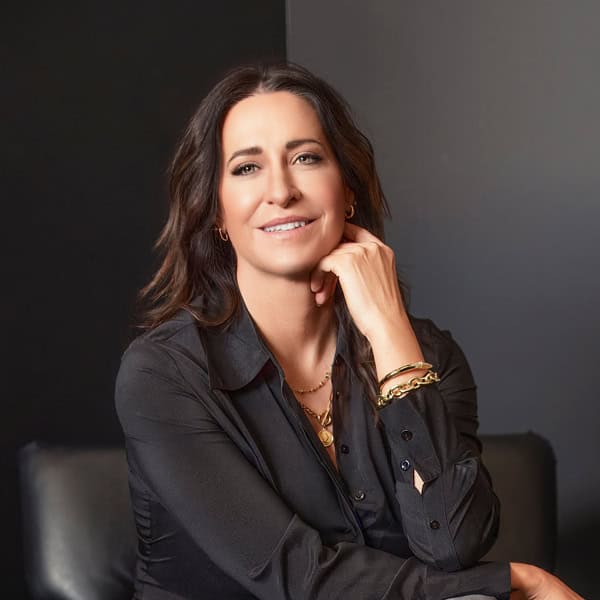Blogs
Scoliosis Care Without Surgery: Treatment Options

There is more than one approach to treating scoliosis, and choosing the type of treatment to commit to can have long-term effects. As a progressive condition triggered by growth, it has to be managed proactively, particularly in children.
Scoliosis is a spinal condition, but its effects can be felt throughout the body, and because it’s progressive, how it’s managed is key. Scoliosis treatment options include invasive spinal fusion surgery, or a combination of scoliosis-specific chiropractic care, exercise, and bracing.
Before getting to the specifics of nonsurgical scoliosis treatment, let’s talk generally about the main differences between a traditional and conservative scoliosis treatment approach.
Scoliosis Treatment Approach
Patients diagnosed with scoliosis have developed an unnatural sideways-bending spinal curve that rotates, and as a progressive condition, its nature is to become more severe over time.
Following a diagnosis of scoliosis, patients have to decide on the type of treatment they want to commit to, and as an ongoing condition, how it’s managed is key.
 Scoliosis can be highly treatable, particularly with early detection and intervention, but not all treatment approaches value a proactive response.
Scoliosis can be highly treatable, particularly with early detection and intervention, but not all treatment approaches value a proactive response.
Scoliosis progression is triggered by growth, and progression means the size and rotation of the unnatural spinal curve is getting worse, and the more scoliosis progresses, the less responsive the spine can become due to increasing spinal rigidity.
So the sooner scoliosis treatment is started, the better.
Traditional scoliosis treatment was the dominant choice for many years, and this approach is more reactive than proactive.
Traditional Surgical Treatment
Traditional scoliosis treatment commonly recommends watching and waiting in mild cases, but because it’s progressive, even mild cases can progress quickly and become moderate and/or severe.
When scoliosis is mild is the best time to act because it means the curve is small, flexible, its effects aren’t yet well established, and it’s likely to be highly responsive.
There are never treatment guarantees, but early diagnosis and treatment is associated with treatment success. It’s important for patients to understand, however, that the potential benefits of early detection are only available to those whose treatment approach is proactive and conservative.
Other than traditional bracing in the moderate stage, little is done to prevent scoliosis progression, and when/if a patient progresses into the severe classification, spinal fusion is commonly recommended.
Spinal fusion surgery is invasive, as all spinal surgeries are, and carries some serious potential risks, side effects, and complications.
Spinal fusion involves identifying the curve’s most-tilted vertebrae, removing intervertebral discs that sit between vertebrae to be fused, and fusing them into one solid bone to prevent further movement (progression), and metal rods are commonly attached to either side of the spine to maintain its position.
Spinal fusion surgery can straighten a bent spine, but immobilizing a portion of the spine can have its effects; a spine that’s fused is weaker and more vulnerable to injury, less flexible, and can be painful due to excessive rigidity.
Conservative treatment, however, is less invasive and works towards preserving as much of the spine’s natural strength and function as possible.
Conservative Nonsurgical Scoliosis Treatment
Here at the Scoliosis Center of Utah, we specialize in proactive nonsurgical scoliosis treatment options.
The goal of conservative treatment is accurate assessment, early detection, and proactive treatment.
A reactive treatment response has the goal of working towards preventing: preventing scoliosis progression, increasing effects, and the need for surgical treatment.
The larger a scoliosis is, the more it’s likely to progress, so the goal is to start treatment while it’s mild, manage it proactively during growth, and prevent mild scoliosis from becoming moderate and/or severe.
Conservative treatment is started as close to the time of diagnosis as possible; there is no watching and waiting as this is wasting valuable treatment time, particularly in children facing the constant progressive trigger of growth.
Nonsurgical treatment is not only proactive, it’s integrative. It recognizes the complexity of scoliosis and that it needs to be impacted on multiple levels.
Nonsurgical treatment combines the potential of multiple scoliosis-specific treatment disciplines for the best potential results.
ScoliBalance®
ScoliBalance® is a complete exercise-based scoliosis treatment program that combines the power of scoliosis-specific chiropractic care with corrective exercise.
Approximately 2 percent of the world’s chiropractors are certified in the highly-specialized modality of Chiropractic BioPhysics® (CBP), and this combines the principles of chiropractic care with the potential corrective power of scoliosis-specific exercise.
CBP uses a series of techniques and manual adjustments to improve the spine’s alignment, and scoliosis-specific physical therapy can help support the spine’s straighter position by improving its surrounding muscle balance and strength.
Scoliosis patients are taught postural awareness through the use of Mirror Image scoliosis-specific exercises, and when the exercises can be performed accurately and consistently in-clinic, patients can perform the exercises from home to further heal and stabilize the spine.
 Scoliosis-specific exercise can help strengthen the spine’s surrounding muscles for more support, improve muscle balance for more stability, increase the spine’s flexibility, reduce the curve, slow/stop progression, and improve the body’s overall position and posture.
Scoliosis-specific exercise can help strengthen the spine’s surrounding muscles for more support, improve muscle balance for more stability, increase the spine’s flexibility, reduce the curve, slow/stop progression, and improve the body’s overall position and posture.
Spinal health and body posture are interconnected; improving posture will improve the health of the spine and vice versa.
When chiropractic care and scoliosis-specific exercise are combined with corrective bracing, the scope of nonsurgical treatment widens further.
ScoliBrace®
Corrective bracing is at the center of nonsurgical treatment, particularly for childhood scoliosis as growing spines are more malleable and responsive to bracing.
The ScoliBrace® places the spine in an overcorrective position, and because the ScoliBrace® was designed with movement in mind, it can be combined with scoliosis-specific exercise for a complete approach to 3-dimensional correction.
The ScoliBrace® is a customized brace that uses state-of-the-art scanning technology to ensure each brace is specific to a patient’s body and scoliosis type.
The customization of the ScoliBrace® also makes it more comfortable for better rates of compliance; no brace can be effective if it’s not being worn precisely as prescribed which can involve full-time wear.
The ScoliBrace® can help improve the spine’s alignment and body posture, and when combined with the potential of scoliosis-specific chiropractic care and physical therapy, positive nonsurgical treatment outcomes can be highly effective.
Conclusion
There was a time when surgery was the main scoliosis treatment option, but we have since learned that, particularly with early detection and intervention, many scoliosis patients respond well to nonsurgical treatment options.
Spinal fusion surgery can stop scoliosis from progressing by immobilizing the fused portion, but this isn’t the same as working towards corrective results that involve reducing the curve size, improving the spine’s alignment, and supporting the structural changes with strong and balanced surrounding muscles.
Traditional scoliosis treatment involves a lot of observation, but not as much active treatment, whereas nonsurgical conservative treatment options are proactive and integrate multiple scoliosis-specific treatment disciplines for the best potential results.
The key to scoliosis treatment is being proactive because as a progressive condition, it can change quickly, and the best way to minimize the potential effects of scoliosis is to treat it proactively.
Improving the spine’s alignment doesn’t just improve the health of the spine and its surroundings, but the entire body; if the spine is not in alignment, the body isn’t balanced, and this type of instability can get worse over time and lead to a number of issues.

Dr. Katalina Dean
Dr. Katalina Dean is the founder and clinical director of Scoliosis Center of Utah, in Midvale, UT. Her team specializes in posture correction, spinal rehabilitation, and non-invasive scoliosis care and bracing.
Call Today
Do You Qualify for Care?
Schedule an Appointment Below
